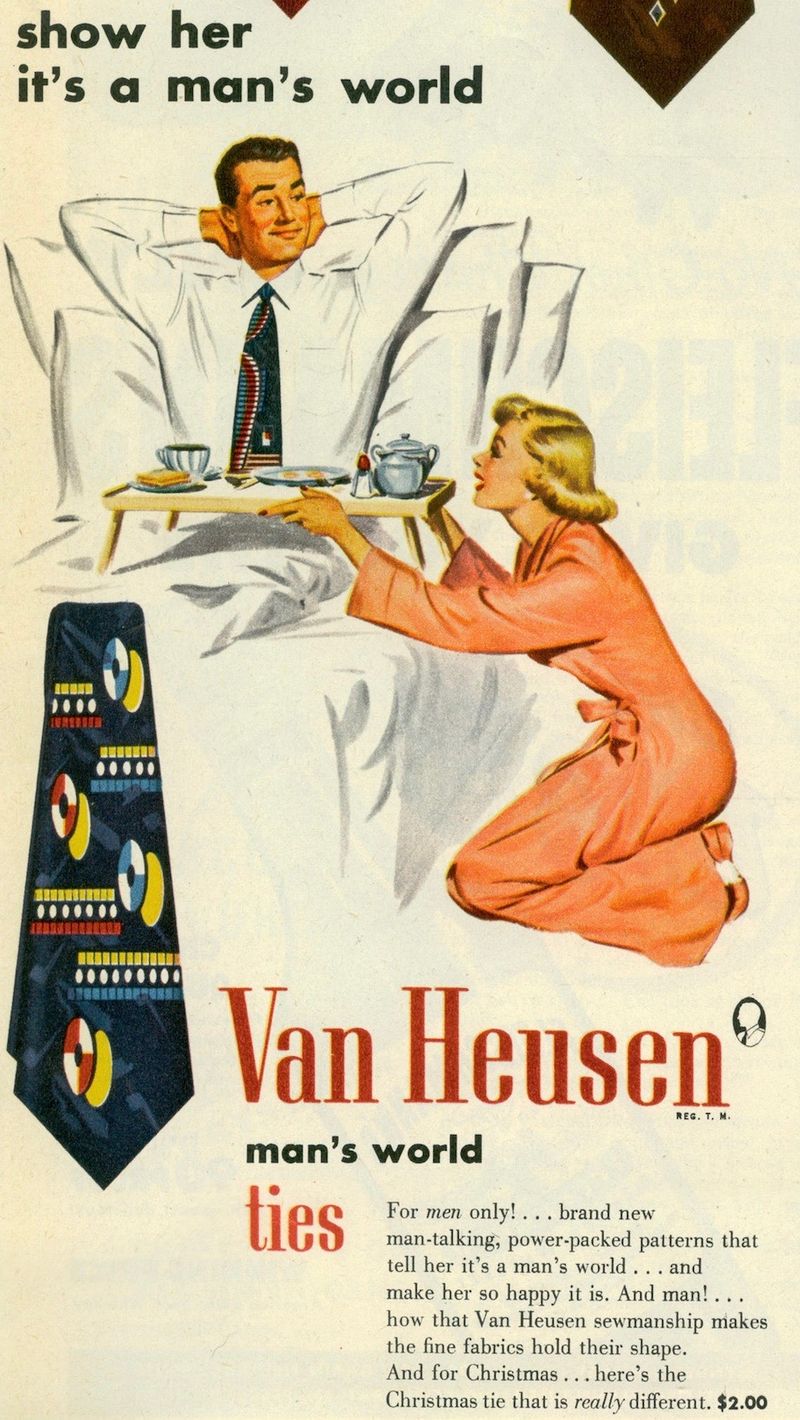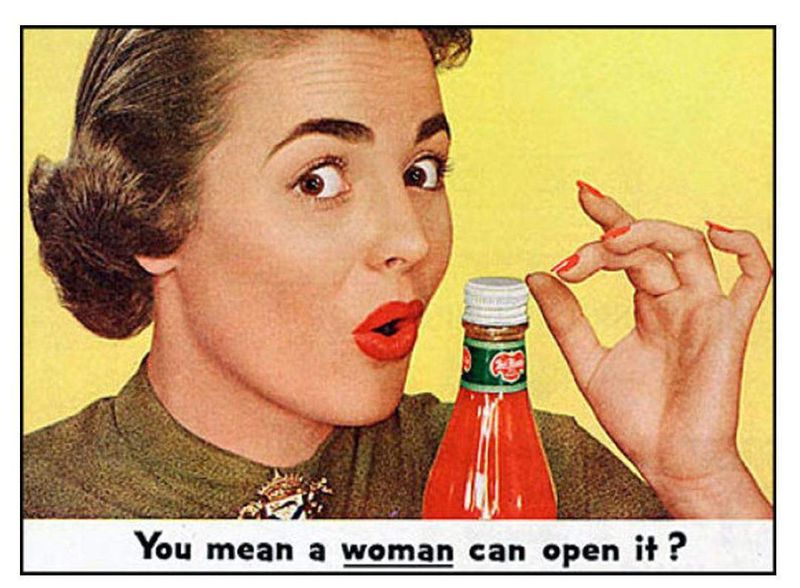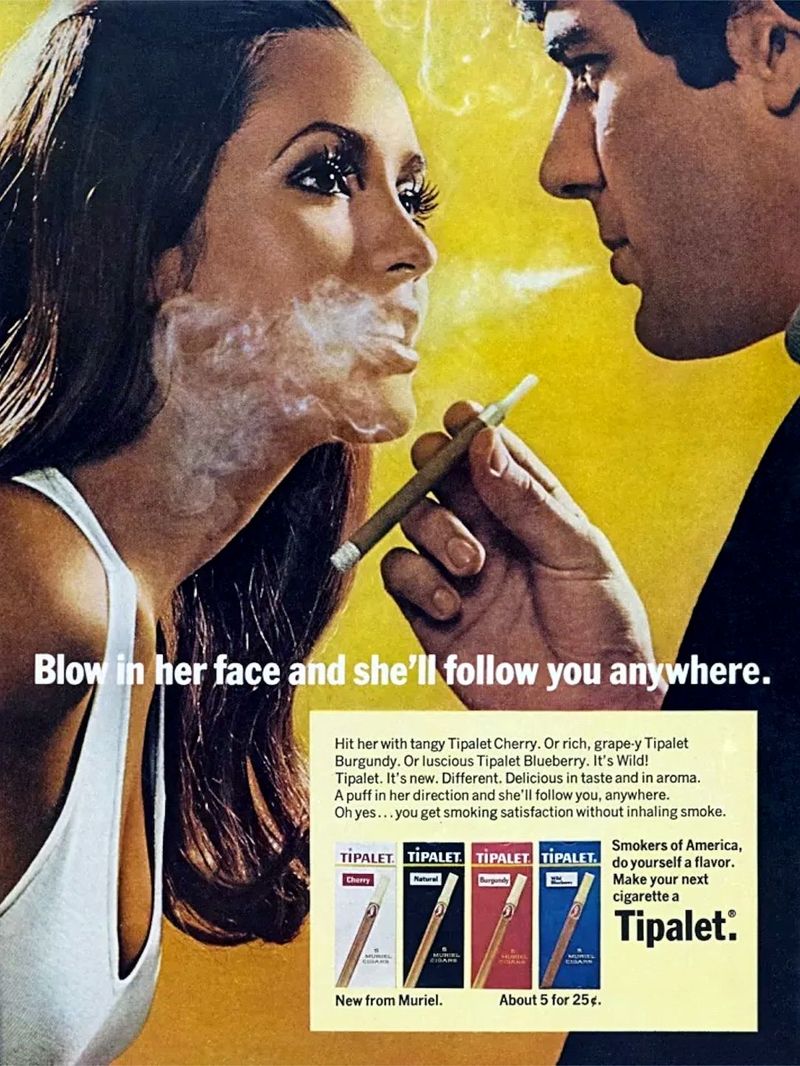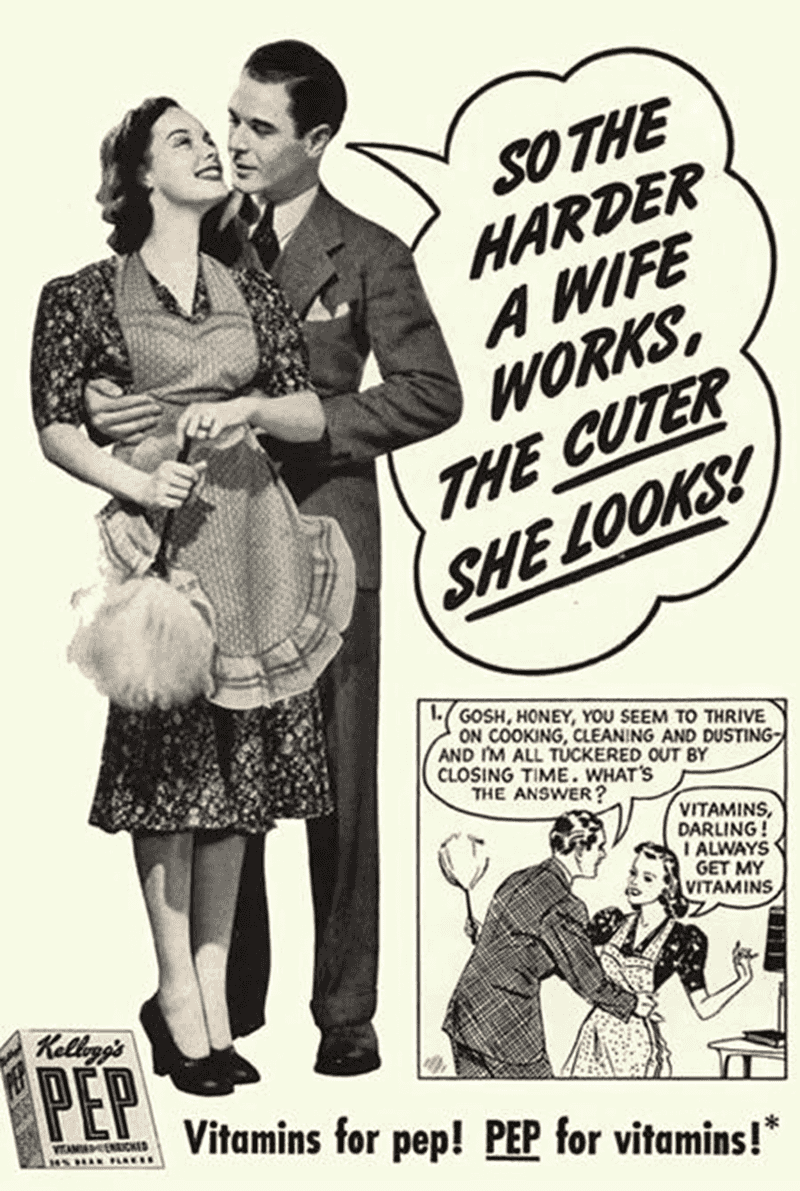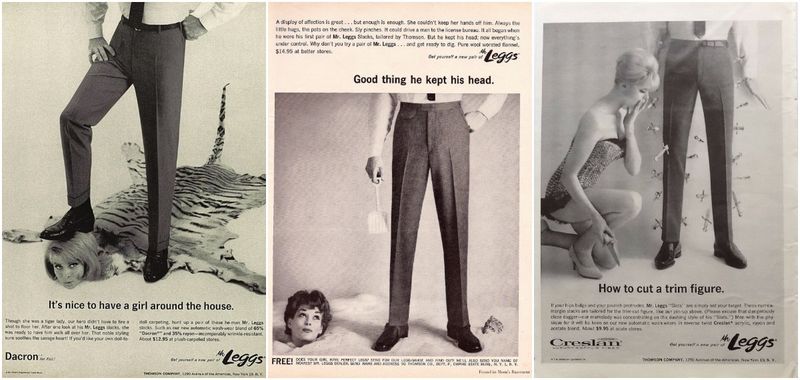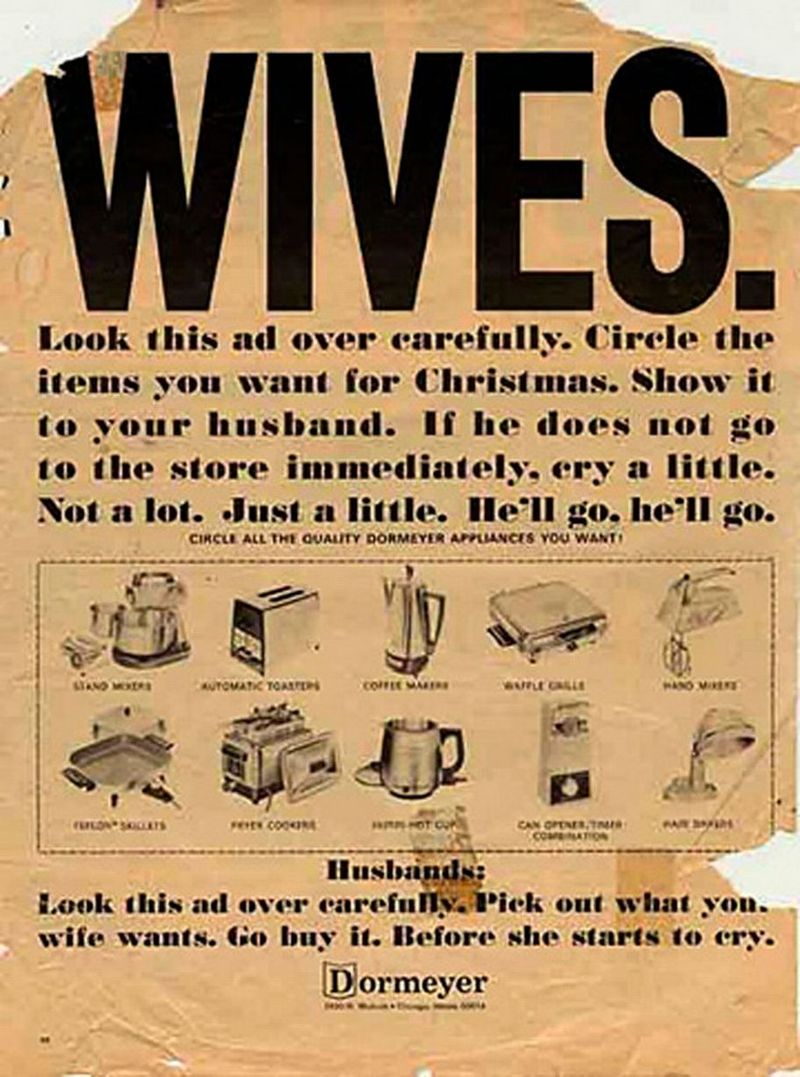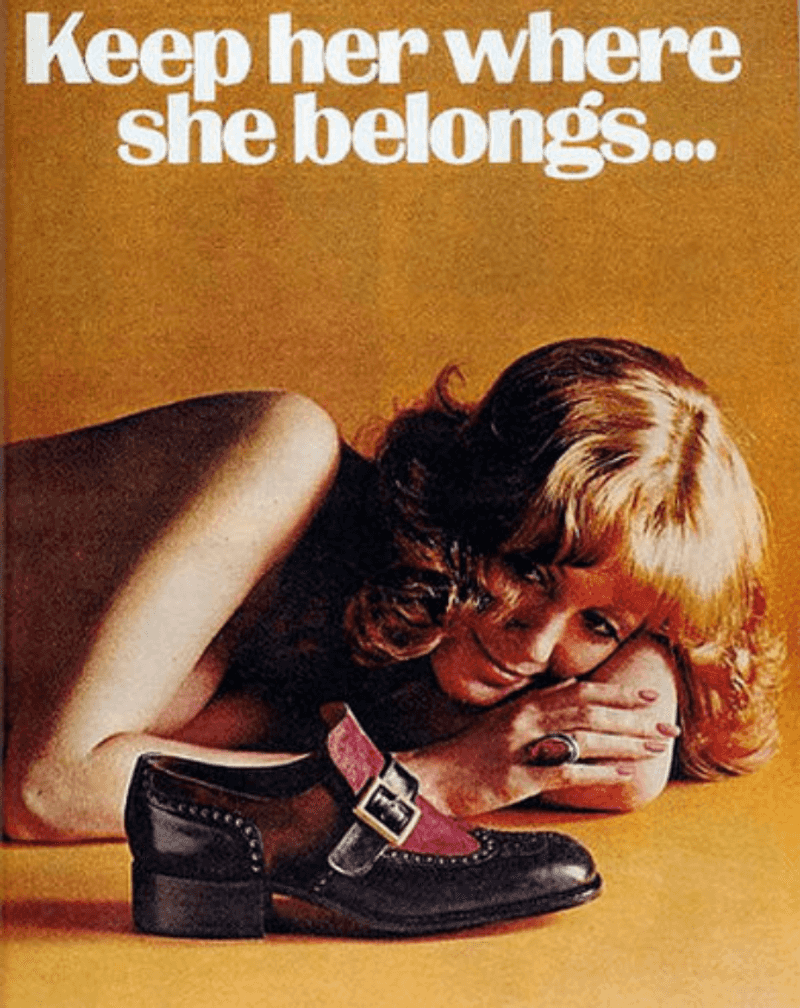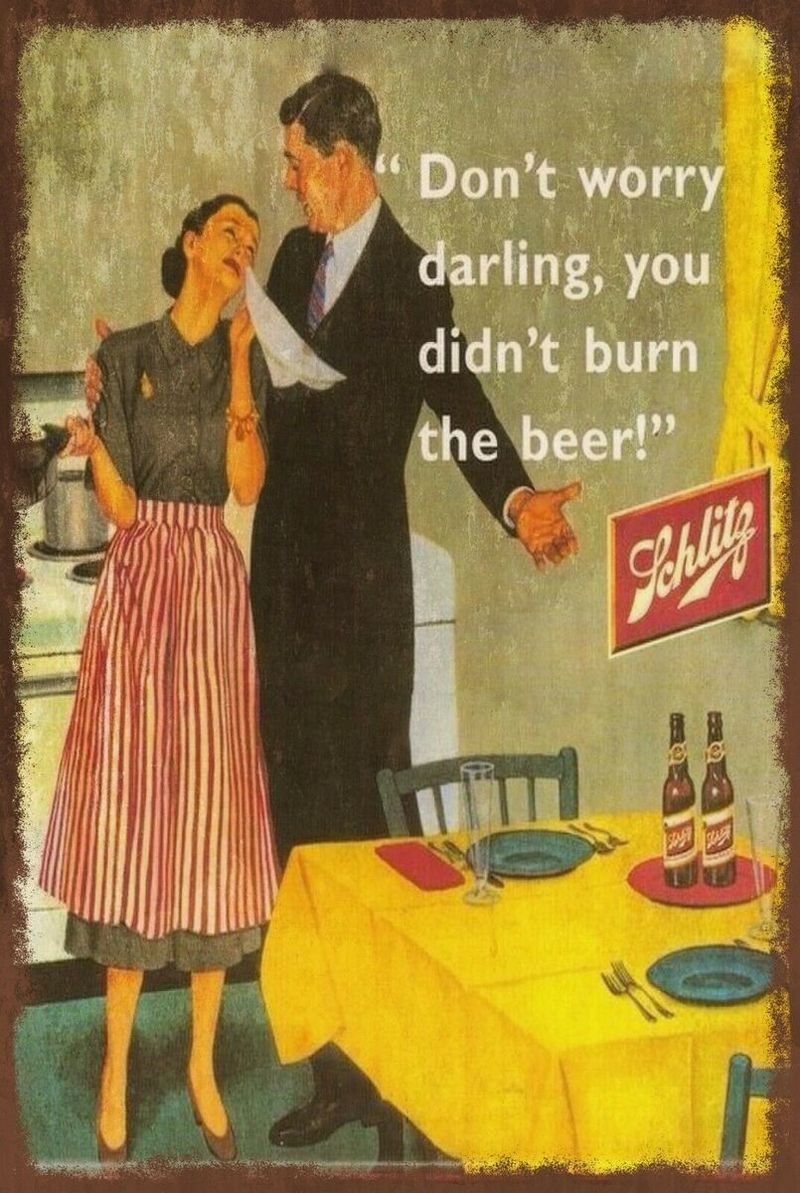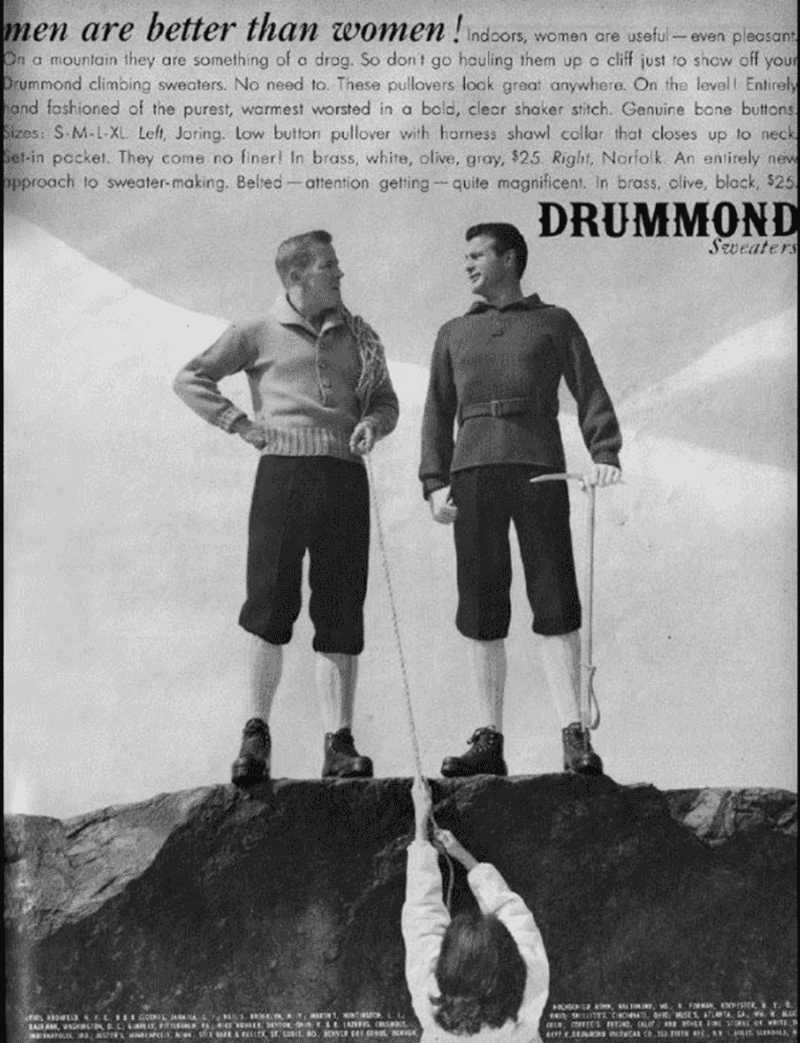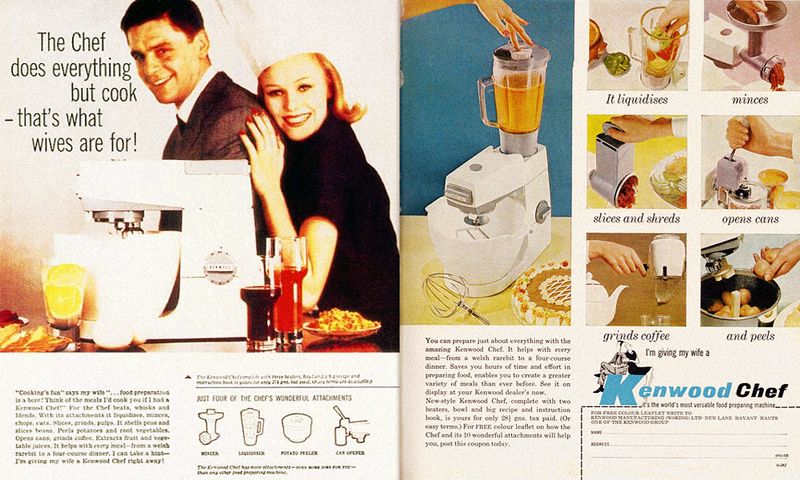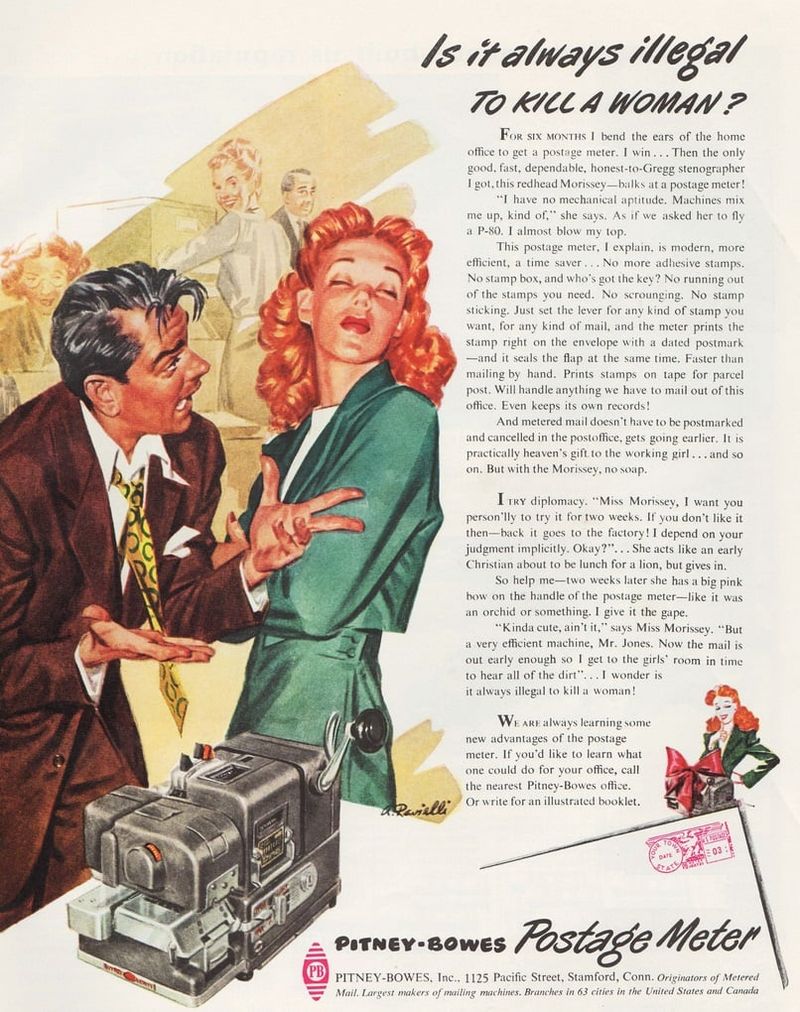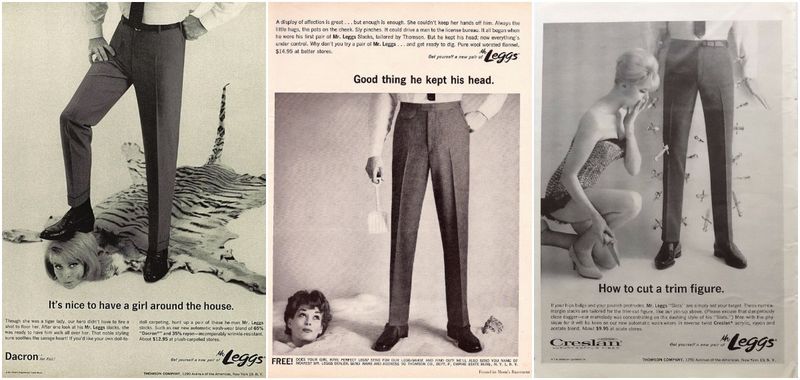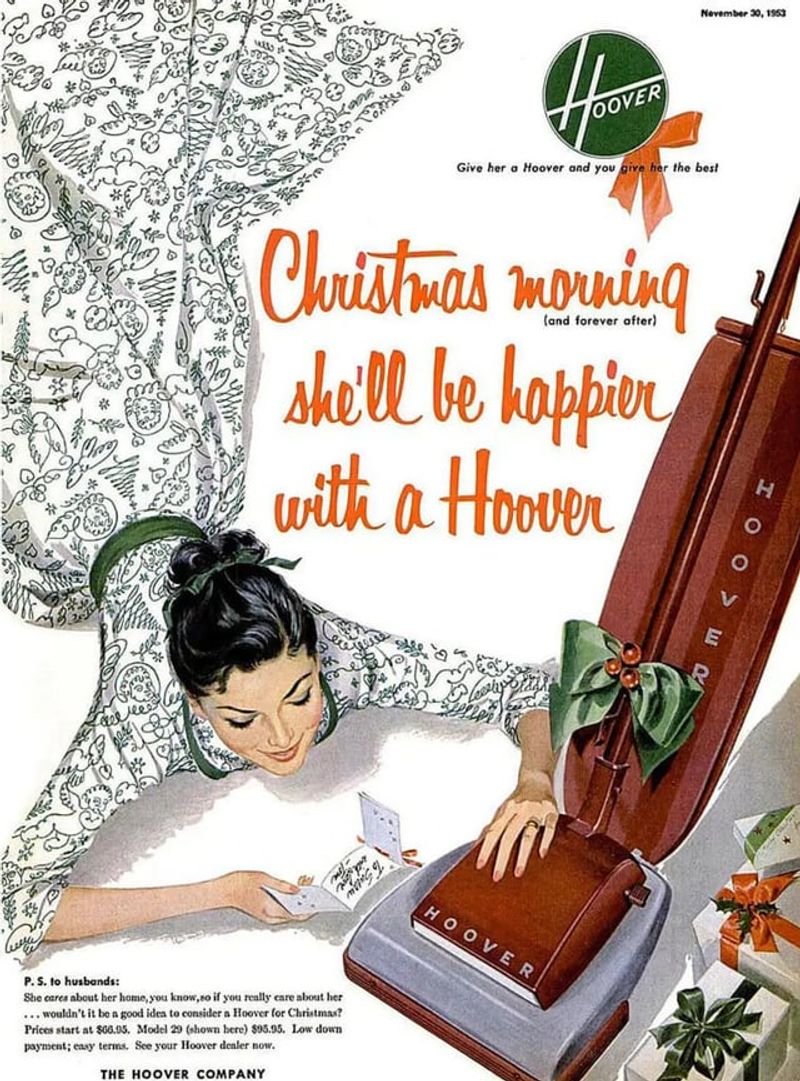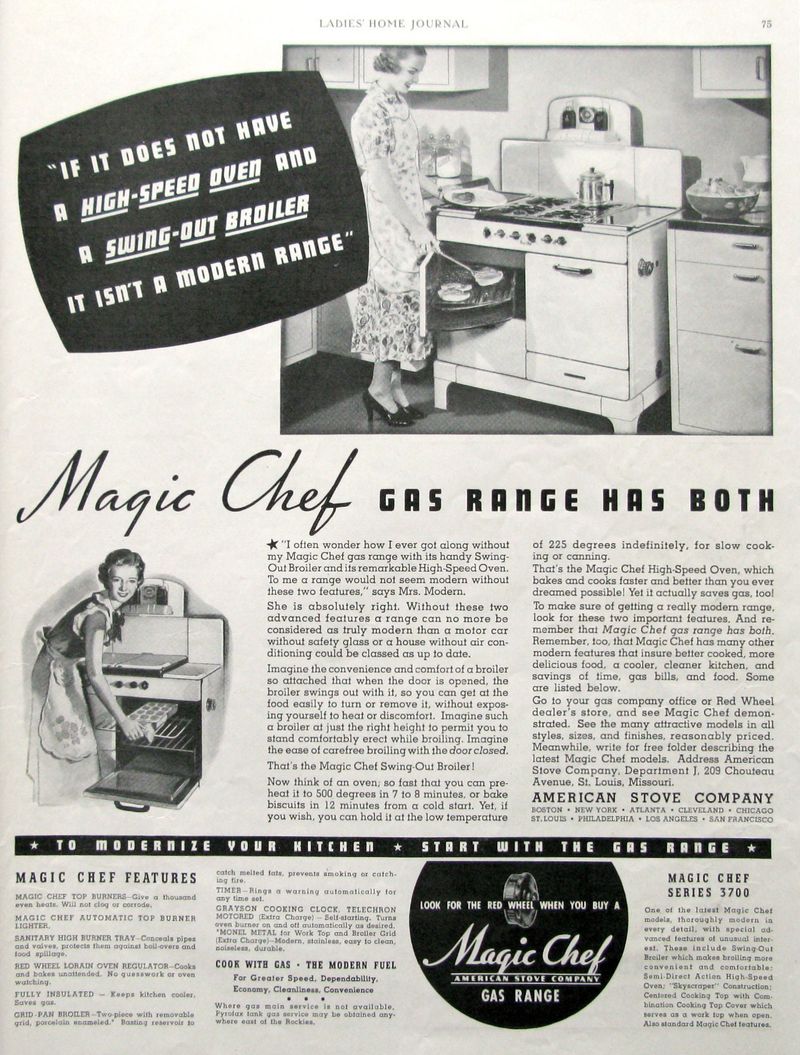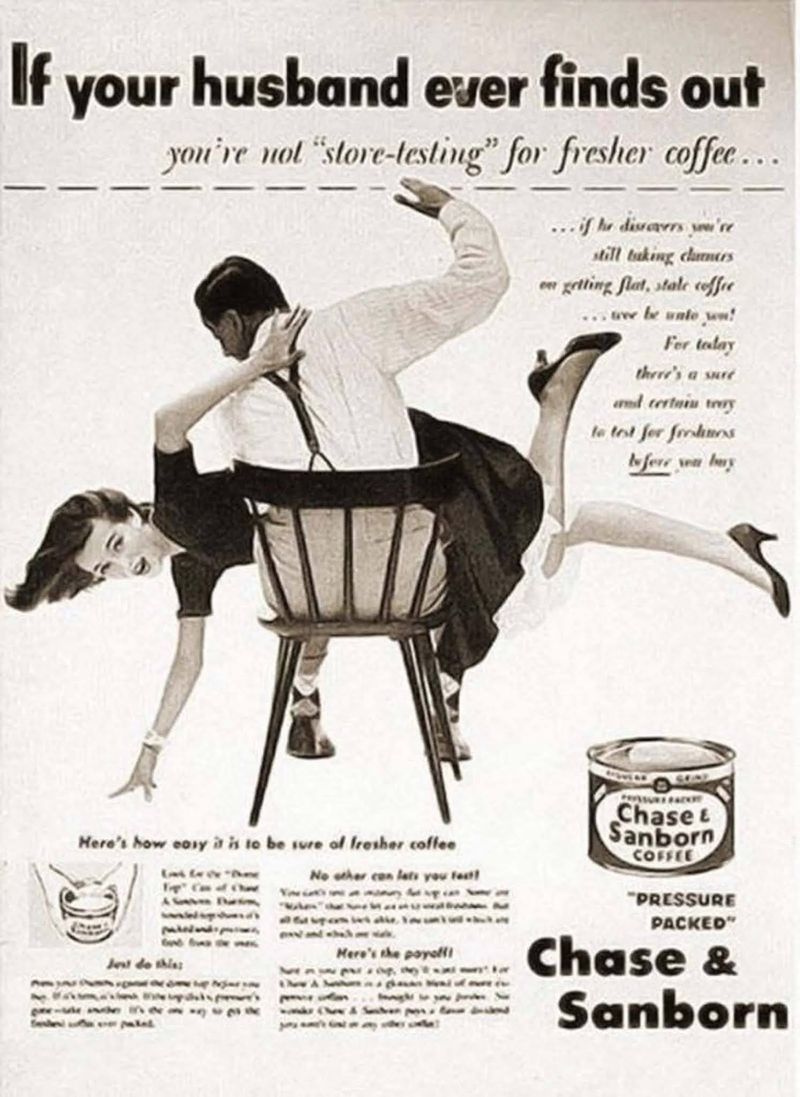Advertising in the mid-20th century often reflected societal norms and stereotypes that are jarring by today’s standards. Vintage ads, particularly from the 1930s to 1970s, frequently portrayed women in a shockingly sexist light.
This blog post explores 15 examples where advertisers used derogatory or demeaning messages aimed at reinforcing gender stereotypes.
Through examining these ads, we can better understand the cultural context of those times and appreciate the progress that has been made, while acknowledging the work still needed for gender equality.
1. “Show Her It’s a Man’s World” – Van Heusen Ties (1951)
The 1951 Van Heusen ad boldly declared, “Show Her It’s a Man’s World,” promoting ties with a message that reinforced male dominance. Presented with a confident, suited man gazing into the distance, this advertisement suggested that power and authority were attributes of masculinity.
Meanwhile, a woman appeared in the background, looking pleased and seemingly in agreement with this notion. The ad insisted that new tie patterns were speaking the language of men, as if women were merely spectators in a man’s world. Such imagery exemplified how advertisements perpetuated gender imbalances during this era.
2. “You Mean a Woman Can Open It?” – Alcoa Aluminum (1953)
Alcoa Aluminum’s 1953 ad asked, “You Mean a Woman Can Open It?” and showcased a woman successfully using a twist-off cap. This subtle jab was intended to highlight the product’s ease of use, but it relied on the stereotype of women being incapable of simple tasks.
The woman’s wide-eyed surprise served to reinforce a narrative of female incompetence without male assistance. Such advertising not only diminished women’s abilities but also echoed a broader cultural sentiment of male superiority, suggesting that even basic achievements were noteworthy for women during that time.
3. “Blow in Her Face and She’ll Follow You Anywhere” – Tipalet Cigarettes
Tipalet Cigarettes’ ad promised that a man could blow smoke in a woman’s face and she would follow him anywhere. The scene depicted a suave man exhaling smoke, while the woman appeared captivated and drawn to him, as if under a spell. This imagery implied a troubling dynamic where women were portrayed as easily manipulated and lacking agency.
By equating cigarette smoke with allure and control, the ad underscored a pervasive attitude of male dominance, reducing women’s independence and reinforcing harmful gender stereotypes prevalent in advertising.
4. “So the Harder a Wife Works, the Cuter She Looks!” – Pep Vitamins (1939)
Pep Vitamins’ 1939 ad claimed, “The Harder a Wife Works, the Cuter She Looks!” and showcased a cheerful housewife immersed in household chores. This message suggested that a woman’s value and attractiveness were directly tied to her domestic labor.
The smiling woman, seemingly content with her role, was depicted in a manner that promoted traditional gender roles, reinforcing the idea that women’s fulfillment was found in serving their families. This advertisement perpetuated the notion that women’s worth was measured through their ability to maintain a home and please their husbands.
5. “It’s Nice to Have a Girl Around the House” – Mr. Legg’s Slacks (1960)
Mr. Legg’s 1960 ad proclaimed, “It’s Nice to Have a Girl Around the House,” with an image of a man smartly dressed in slacks, while a woman sat at his feet in a pose of submission. The advertisement suggested that a man’s choice of clothing could influence a woman’s demeanor, making her more agreeable and obedient.
The underlying message reinforced a dynamic of control and subservience, indicating that women were ornamental and secondary to men’s preferences. Such imagery underscored the sexist undertones prevalent in advertising during this era.
6. “Wives! Look This Ad Over Carefully” – Sheaffer’s Pens (1940s)
In this 1950s advertisement, Dormeyer directly addresses wives with the instruction: “Look this ad over carefully. Circle the items you want for Christmas. Show it to your husband. If he does not go to the store immediately, cry a little… Not a lot. Just a little. He’ll go. He’ll go.”
The ad features a selection of kitchen appliances, such as mixers and toasters, suggesting that these are the ideal gifts for wives. It implies that women should use emotional persuasion, even feigned tears, to influence their husbands into purchasing these items.
fichier-pdf.fr
7. “Keep Her Where She Belongs” – Weyenberg Massagic Shoes (1970s)
“Keep Her Where She Belongs” – Weyenberg Massagic Shoes (1970s)
This ad for Weyenberg shoes features a sharply dressed man relaxing in a posh chair, while a woman — positioned lower on the floor — lovingly polishes his shoe. The headline reads: “Keep her where she belongs.”
The message is unmissably clear: the man’s dominance is linked not just to style or confidence, but to the submission and servitude of the woman at his feet. It presents this dynamic as aspirational — the implication being that Weyenberg shoes help men maintain control and authority, especially over women.
8. “Don’t Worry Darling, You Didn’t Burn the Beer!” – Schlitz Beer (1950s)
Schlitz Beer’s 1950s ad comforted a tearful wife with, “Don’t Worry Darling, You Didn’t Burn the Beer!” The scene presented a husband reassuring his distraught wife, who had burnt dinner yet managed to successfully serve beer.
This narrative trivialized the woman’s distress, reducing her worth to her ability to serve drinks rather than cook. Such imagery reinforced the stereotype that women were primarily responsible for pleasing their husbands and diminished their capabilities beyond domestic roles. The ad highlighted how humor was inappropriately used to perpetuate gender biases in that era.
9. “Men are Better Than Women! Indoors, Women are Useful — Even Pleasant…” – Pitney-Bowes (1950s)
Pitney-Bowes’ 1950s ad boldly claimed, “Men are Better Than Women! Indoors, Women are Useful — Even Pleasant…” This condescending message proclaimed male superiority while relegating women to domestic roles.
The visual of a man engaged in business, juxtaposed with a woman cleaning in the background, emphasized traditional gender roles and hierarchy. By glorifying men’s capabilities outside the home while patronizingly acknowledging women’s contributions indoors, the ad mirrored societal beliefs that limited women’s opportunities and painted them as secondary in value and competence.
10. “The Chef Does Everything But Cook — That’s What Wives Are For!” – Kenwood (1960s)
Kenwood’s 1960s ad asserted, “The Chef Does Everything But Cook — That’s What Wives Are For!” implying that while men could purchase the latest kitchen gadgets, the cooking remained a woman’s responsibility.
The ad depicted a husband, satisfied with his appliance purchase, and a wife dutifully preparing meals. This reinforced the notion that a woman’s primary role was domestic, catering to her husband’s needs. Such imagery perpetuated outdated gender roles, where technology served men’s interests while women maintained traditional duties. This ad exemplified the era’s deep-seated sexism in marketing.
11. “Is it always illegal to kill a woman?” – Pitney-Bowes Postage Meter (1947)
“Is It Always Illegal to Kill a Woman?” – Pitney-Bowes Postage Meter (1947)
This vintage ad features a male office manager expressing frustration over his secretary, Miss Morissey, who initially resists using a new postage meter, claiming, “I have no mechanical aptitude. Machines mix me up, kind of.”
After some persuasion, she not only adopts the machine but decorates it with a pink bow, remarking, “Now the mail is out early enough so I get to the girls’ room in time to hear all the dirt.” The ad concludes with the manager’s exasperated thought: “I wonder is it always illegal to kill a woman!”
12. “It’s Nice to Have a Girl Around the House” – Mr. Leggs (1967)
Mr. Leggs’ 1967 ad mirrored its earlier version, asserting, “It’s Nice to Have a Girl Around the House,” with a woman depicted as a literal rug beneath a man’s feet. This visual metaphor emphasized male dominance and female submission, reducing women to mere adornments in a man’s world.
By portraying a woman as something to be stood upon, the ad reinforced ideas of patriarchy and control. Such imagery reflected a persistent cultural narrative that valued women primarily for their decorative, rather than substantive, presence in society.
13. “She’ll be Happier with a Hoover” – Hoover Vacuum (1950s)
Hoover’s 1950s ad cheerfully proclaimed, “She’ll be Happier with a Hoover,” depicting a woman joyfully receiving a vacuum cleaner as a gift. This notion suggested that a woman’s happiness was inherently linked to owning household appliances, reinforcing domestic stereotypes.
The image of a woman delighted with a vacuum implied that fulfilling her cleaning duties would bring her joy. Such advertising perpetuated the belief that women were suited primarily for housework, marginalizing their roles and aspirations outside the home. This ad epitomized the era’s endorsement of gender-specific expectations.
14. “Women Don’t Leave the Kitchen” – Vintage Stove Ad
The Vintage Stove ad, declaring, “Women Don’t Leave the Kitchen,” romanticized a woman’s role in the household. It depicted a serene woman happily preparing meals, embodying the stereotypical housewife. This advertisement perpetuated the notion that a woman’s place was in the kitchen, serving her family.
By idealizing domesticity, the ad reinforced societal constraints on women’s roles, limiting their opportunities for personal and professional growth. The imagery served as a reminder of the cultural norms that dictated women’s positions within the home, reflecting broader societal attitudes of the time.
15. “If Your Husband Ever Finds Out…” – Van Heusen Shirts
Van Heusen’s ad, “If Your Husband Ever Finds Out…,” depicted a stern-looking man receiving breakfast in bed from a nervous woman. This imagery suggested potential consequences if she failed in her domestic duties.
The narrative played on fears of displeasing a husband, perpetuating the idea that a woman’s primary role was to serve and satisfy her spouse. By insinuating that failure in these duties could result in reprimand, the ad underscored the power imbalance and control dynamics prevalent in many households. Such messages reflected the societal acceptance of gender inequality.

